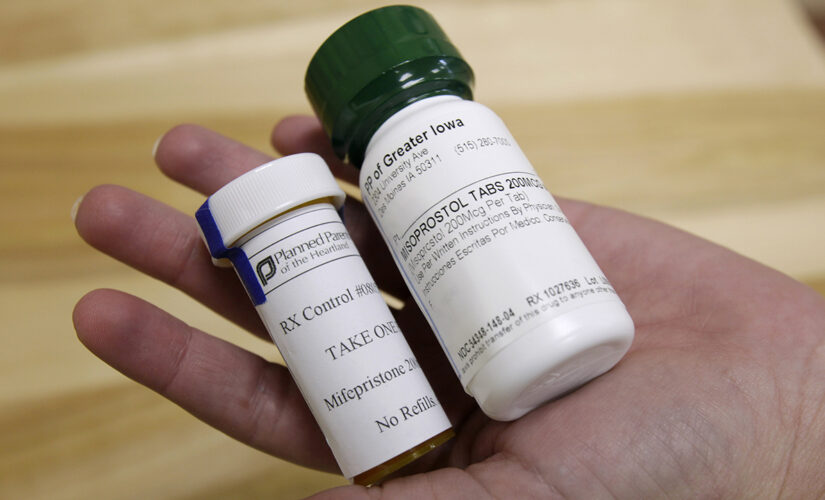NEWYou can now listen to Fox News articles!
The Food and Drug Administration (FDA) loosened restrictions on telemedicine abortions in a letter Thursday that officially reversed an in-person dispensing requirement maintained by the Trump administration.
“After conducting a review of the single, shared system Risk Evaluation and Mitigation Strategy (REMS) for mifepristone, known as the Mifepristone REMS Program, FDA determined that the data support modification of the REMS to reduce burden on patient access and the health care delivery system and to ensure the benefits of the product outweigh the risks,” the FDA said on its “Questions and Answers on Mifepristex” page.
It also included a requirement that pharmacies dispensing the drug be certified.
Former President Trump’s FDA previously said the restrictions “ensure that the benefits of the drug outweigh its risks.”
The in-person dispensing requirement became critical during the early stages of the coronavirus pandemic as women encountered additional hurdles in reaching medical services. After the FDA relaxed regulations in April, the American College of Obstetricians and Gynecologists (ACOG) praised the decision as a way to protect patients and medical professionals from contracting COVID-19 during in-person visits. It also maintained that studies had shown the drug to be “a safe, effective medication.”
FDA’S REMOVAL OF RESTRICTIONS ON TELEMEDICINE ABORTIONS PROMPTS CELEBRATION, SAFETY CONCERNS
Lila Bonow, Alana Edmondson and Aiyana Knauer prepare to take an abortion pill while demonstrating in front of the U.S. Supreme Court as the justices hear arguments in Dobbs v. Jackson Women’s Health, a case about a Mississippi law that bans most abortions after 15 weeks. (Chip Somodevilla/Getty Images)
But anti-abortion advocates argue that telemedicine abortions carry weighty – potentially lethal – consequences that may not be fully captured by FDA data, which they say is woefully inadequate.
The American Association of Pro-Life Obstetricians and Gynecologists (AAPLOG) has said in-person visits are critical to detecting ectopic pregnancies, which can be life-threatening; ensuring accurate estimations of gestational age; and for determining whether women need the medication Rhogam, which is used to prevent complications in future pregnancies.
“The FDA has surrendered to faulty data and bad science promoted by abortion industry lobbyists and put the health of women and girls at risk,” said Dr. Tara Sander Lee, senior fellow and director of life sciences at the anti-abortion Charlotte Lozier Institute (CLI).
“The latest evidence-based science and data confirm that chemical abortion leads to surging rates of emergency room utilization and life-threatening complications, including severe bleeding, infection and the need for surgery. Sadly, at least 20 women have died as a result of the abortion pill under the FDA’s watch, and those are just the cases we know about. Women should absolutely avoid this drug, both for their own health and the health of their baby. Today the FDA failed to stand up to the abortion lobby and failed in its duty to provide oversight and safeguards that protect women and girls.”
CHEMICAL ABORTIONS SAW 500% INCREASE IN RATE OF ER VISITS FROM 2002-2015: STUDY
(Photo Illustration by Pavlo Gonchar/SOPA Images/LightRocket via Getty Images)
Janet Woodcock, the acting FDA commissioner, previously said existing literature didn’t appear to show increases in serious safety concerns (ectopic pregnancy, hemorrhage and surgical interventions) as a result of modifying the in-person requirement during COVID-19.
She added that the Center for Drug Evaluation and Research, housed within the FDA, found that “the small number of adverse events reported to FDA during COVID-19 … provide no indication that any program deviation or noncompliance with the Mifepristone REMS Program contributed to the reported adverse events.” REMS – Risk Evaluation and Mitigation Strategy – refers to safety protocols for taking the medication.
Thursday’s decision comes just after the Supreme Court heard oral arguments in a case that could overturn Roe v. Wade and effectively drive interest in alternatives like chemical abortions.
Some states have attempted to restrict the practice but will ultimately encounter greater difficulty as women can obtain pills through the mail.
“We’re set up to do whatever’s necessary,” Aid Access founder Dr. Rebecca Gomperts has reportedly said. Gomperts’ website provides mifepristone to women in all 50 states.
Even with the assurances of in-person dispensing, the abortion “pill” – a combination of mifepristone and misoprostol – leads to heated debate. Use of the pill has increased to 50% of all abortions in 2020 after the FDA’s authorization in 2000, according to CLI.
An abortion pill ‘PiDaNa from HRA Pharma’ in a rumpled bed Nov. 28, 2013 in Bonn, Germany. (Ute Grabowsky/Photothek via Getty Images)
Last month, CLI released the results of a study that determined abortion pill complication rates by combing through years of Medicaid data. It found that “abortion-related” ER visits were higher and increased at a faster rate (per 1,000 abortions) for the chemical version than they did after surgical procedures. Specifically, chemical abortion visit rates increased by 507% (8.5 to 51.7 per 1,000) between 2002 and 2015. During that same period, the surgical abortion visit rate increased 315%.
CLI’s study aligns with one from Finland, which has a single-payer system that makes tracking the issue easier. That 2009 study, which used a cohort of more than 42,000 women, found that chemical abortions saw a four-fold higher rate of adverse events compared to surgical. It concluded, however, that both forms are generally safe.
CLICK HERE TO GET THE FOX NEWS APP
More recently, a Canadian study compared overall abortion outcomes before and after mifepristone became available without restrictions in the country.
“After mifepristone became available as a normal prescription, the abortion rate remained relatively stable, the proportion of abortions provided by medication increased rapidly and adverse events and complications remained stable, as compared with the period when mifepristone was unavailable,” it concluded.
Sam Dorman is a reporter with Fox News. Follow him on Twitter @DormanInDC or at facebook.com/SamDormanFoxNews




